|
|
| The secret is to pull her free of the surface tension just below the stall speed and keep her airborne. Thrust rather than pure aerodynamics will be what gets you flying. My favorite trick is to launch off the last big swell and then dump the flaps to leave her "hanging on the prop!" |
The only difference with a
heavy load is that you have to milk or play the controls according to
the incoming swells. As you will be on the water longer than when
lightly loaded, you have to feel out each swell and ride them as clean
as possible to prevent crashing into the big ones. This initially meant
pulling back on the control column to go up rather than through the
largest swells, minimizing drag and maximizing speed, and then pushing
ahead during a periods of smaller swells to gain the air speed for
creating lift. With greater lift the floats will rise in the water
producing less surface drag and increasing the speed needed for
lift-off.
But, once you build up speed then
you will have to push or cut your way through the big swells to minimize
the impact and prevent getting launched prematurely, and then pull the
nose up during the period of smaller swells in an attempt to minimize
surface drag when you are just at or below the stall speed. Like I
mentioned earlier, the secret is to pull her free of the surface tension
just below the stall speed and relax on the control column just enough
to keep her airborne. Thrust rather than pure aerodynamics will be what
gets you flying. My favorite trick is to launch off the last big swell
and then dump the flaps to leave her "hanging on the prop!"
I have tried to analyze good heavy
water pilots as they make these moves to visualize what they do, but to
no avail. Although, I know there is a proper way to take off in heavy
water, there does not appear to be any rhyme or reason that you can
teach in a class room. It is rather “just a feelin” for flying that
you have to learn by doing.
The next two trips I flew and
Ian sat in the right seat as a type of line check. I felt like I had not
flown since my days in Fiji where in fact I had just been flying the
same machine in Africa a few weeks before. The environment was so
different from the muddy brown rivers of the tropical rainforests,
however, I felt out of place for a few legs. Finally after a landing or
two at Holiday Island and a trip to Gangehi, I felt more at ease. It is
easy to look lost flying an aircraft you have several thousand hours in
because of a new and foreign environment.
The last trip of my line
check, I accompanied Ian to the island of Kunfunadhoo. 30 minutes to the
north of Male, Kunfunadhoo is the home to
Soneva Fushi Resort, one of
the most natural and ecological friendly developments in the Maldives.
Sonu and Eva, who are both eccentric and genuine, own the resort. I have
learned over the years that most resort owners are definitely eccentric
and usually self-centered and miserly. Sonu and Eva are certainly
prudent when it come down to business, but they were one of the few owners
who regularly greeted all pilots and staff and guests alike with the
same genuine warmth and aplomb, like you were a long lost cousin from
Madrid.
This philosophy showed in their management style
where ideas or suggestions for improvement could come from anywhere. My
son, who was about seven at the time, decided to attend a management
meeting one morning. He was not only welcomed but was encouraged to make
a presentation about how the island bicycles should have mounted lights
so the guests could easily navigate at night. The next day the GM
ordered a set of bicycle lights and thanked my son for his
contributions. Their managerial style was not top down but radiated from
the center. Sonu and Eva were known for doing things
right and their resort is listed as one of the
World's Top 100 Luxury
Small Hotels.
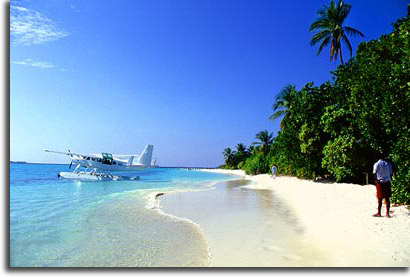 It
was because of them Hummingbird had even one decent aircraft. Sonu was
the younger brother of the new owner of Hummingbird, and he had
requested a factory-fresh leather clad C208 amphib to be their exclusive
guest transport. Sonu got his way and Hummingbird got a new Caravan. In
fact, Sonu was the reason his industrial factory-owning brother, Azad, got into
the airline business in the first place. In order to prop up the
business that he relied upon to transfer his guests to the resort
island, Sonu had bought into Hummingbird Helicopters when they were
being financially drained by the MAT competition. When Sonu was in
threat of being dragged down as well, he called upon his older brother
to carry the day.
It
was because of them Hummingbird had even one decent aircraft. Sonu was
the younger brother of the new owner of Hummingbird, and he had
requested a factory-fresh leather clad C208 amphib to be their exclusive
guest transport. Sonu got his way and Hummingbird got a new Caravan. In
fact, Sonu was the reason his industrial factory-owning brother, Azad, got into
the airline business in the first place. In order to prop up the
business that he relied upon to transfer his guests to the resort
island, Sonu had bought into Hummingbird Helicopters when they were
being financially drained by the MAT competition. When Sonu was in
threat of being dragged down as well, he called upon his older brother
to carry the day.
Azad had the MD for his aluminum
factory in Nigeria look at the feasibility of taking over Hummingbird
and turning it into a competitive floatplane operation. The MD, luckily
for us float plane pilots and unluckily for Azad, knew absolutely
nothing about airlines or airplanes, let alone floatplanes, and came up
with a positive, but badly underestimated assessment. That was the
beginning of a heavy investment of money, aircraft, and experienced
employees into the making of an airline. The dreams of Kit and Sonu become the reality for our
employment.
The factory new 675hp Caravan,
however, was quite nice. Unfortunately the ferry company had done a
wheels up landing at one of the airports enroute and forgot to mention
it on delivery. I noticed on my first walk around that the skids were
missing off the keels and the back keels near the wheels were worn down
to metal mulch. One of the engineers told me that they cut the remainder
of the protective strips off because they were hanging down and broken
on arrival, and didn’t think to mention it to anyone either. Although
that did not stop us from flying, it made me think of a famous Nigerian
saying, "Things fall apart." It literally means that nothing
last forever.
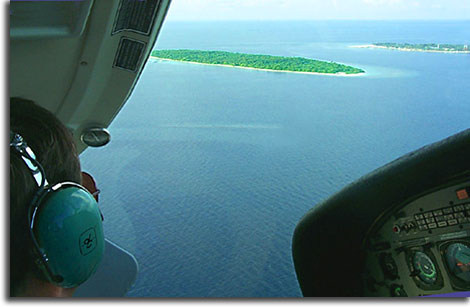
As we approached Soneva Fushi, I could not see any specific area that I would consider a safe landing zone. The island was long and narrow and surrounded by relatively open seas. Although the island was inside the North Baa Atoll, there was really no barrier reef protecting it from the incoming swells. Moreover, the house reef was too tight around the island with no safe landing areas inside. To start operations several weeks before someone had placed a mooring buoy beside the island, but that had proved unusable in any kind of wind as the seas got too rough. So they had moved the buoy inside a nearby lagoon.
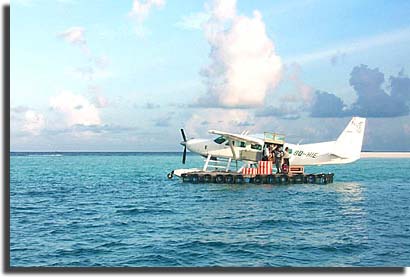 The lagoon was large enough to operate out of, but the reef wasn't high
enough to stop the large rolling swells during the high tides. This
lagoon, although absolutely beautiful in color and form, became one of
our most challenging areas to operate into during the monsoons. The
first day Ian and I landed there was uneventful except that a family of
dolphins had decided to play chicken with us as we lined up for final.
They came on to us head on and only dove as the floats touched the
water.
The lagoon was large enough to operate out of, but the reef wasn't high
enough to stop the large rolling swells during the high tides. This
lagoon, although absolutely beautiful in color and form, became one of
our most challenging areas to operate into during the monsoons. The
first day Ian and I landed there was uneventful except that a family of
dolphins had decided to play chicken with us as we lined up for final.
They came on to us head on and only dove as the floats touched the
water.
Ian and I rode in on the dhoni to
the island and were greeted with cold facecloths and cold drinks. We
stayed long enough to enjoy lunch and then loaded our passengers and
headed back to Male. The passengers were government representatives
inspecting the resort after a major generator fire. Even with no power
the guests had not wanted to leave the island, but Soneva Fushi was forced to
shut down because the health department said so.
Some of the guests had to literally
be carried off the island, including Paul McCartney and his family. Ian
had evacuated them in the new Caravan. Over the next two years Soneva
Fushi
definitely became my family's favorite island retreat. My wife casually
remarks that we lived next door to the villa where Linda
McCartney stayed "in the spring of her death."
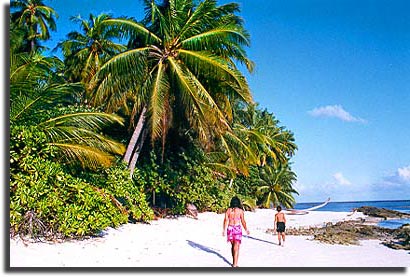
End of Part Three
Article and Images by John S Goulet
![]()
Note from the Editor. Hummingbird Helicopters became Hummingbird Island Airways, and Hummingbird Island Airways no longer exists. It has been sold out, and reincarnated as Trans Maldivian Airways. This story is about the two years it was HIA.
For maintenance concerns about operating your Caravan in saltwater,
read
Seaplanes & Salt Water
Click Here for Hummingbird Twin Otter Desktop Image.
![]()
Use the attitude indicator as your guide back to Knowledge Based
Stories.
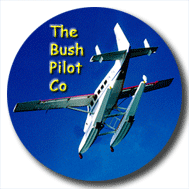 Top of this
page.
Top of this
page.
The
Bush Pilot Company
Last modified on
August 22, 2006 .
© Virtual Horizons, 1996.


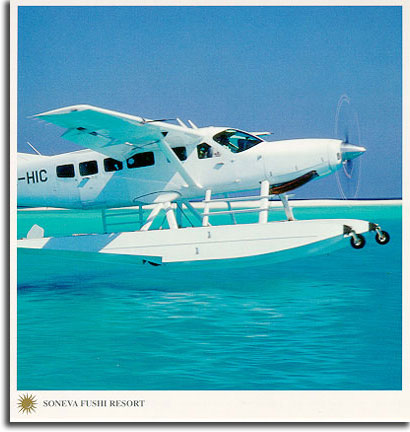 He
could have approach from either direction and put the crosswind at 90
degree to our left, but he knew better. Most floatplanes and tail
draggers will weather cock to the left, which makes a left crosswind
difficult anyway, but the additional culprit working your nose to the
left is asymmetric thrust. The Caravan is especially difficult to
control on take-off or landing with a strong left cross wind and most
knowing pilots will avoid it when ever possible. The Caravan will
control better with a right wind and you can use the power leverage to
your advantage. In other words, when you add power for take-off or to
get you out of a disintegrating situation by pushing the nose down, you
want to be able have an effect that will lever you away from the
crosswind.
He
could have approach from either direction and put the crosswind at 90
degree to our left, but he knew better. Most floatplanes and tail
draggers will weather cock to the left, which makes a left crosswind
difficult anyway, but the additional culprit working your nose to the
left is asymmetric thrust. The Caravan is especially difficult to
control on take-off or landing with a strong left cross wind and most
knowing pilots will avoid it when ever possible. The Caravan will
control better with a right wind and you can use the power leverage to
your advantage. In other words, when you add power for take-off or to
get you out of a disintegrating situation by pushing the nose down, you
want to be able have an effect that will lever you away from the
crosswind.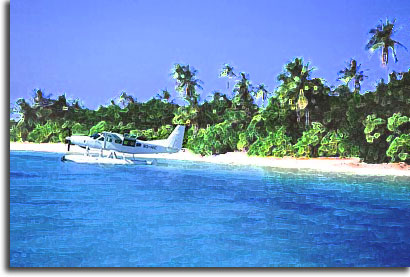 The
first day in Ari Beach, however, I switch seats and flew the take-off.
Although I could have duplicated Ian’s crosswind technique as I had
used it frequently getting in and out of Forcados and Bonny Island on
the Atlantic side of Africa, I wanted to show Ian how I would do a rough
water take-off if I could not parallel or if the wind got too strong.
The upper limit of the Caravan is at about 24 knots, and then you have
to face the music. In this case the freshening wind had picked up
considerable since we landed.
The
first day in Ari Beach, however, I switch seats and flew the take-off.
Although I could have duplicated Ian’s crosswind technique as I had
used it frequently getting in and out of Forcados and Bonny Island on
the Atlantic side of Africa, I wanted to show Ian how I would do a rough
water take-off if I could not parallel or if the wind got too strong.
The upper limit of the Caravan is at about 24 knots, and then you have
to face the music. In this case the freshening wind had picked up
considerable since we landed.